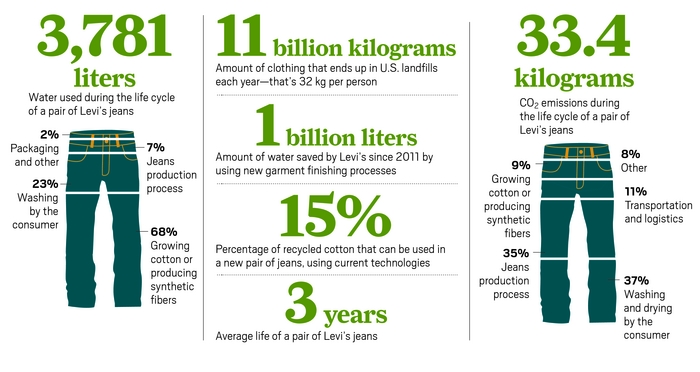The impact that fast fashion has on the planet is tremendous. From the start of production all the way to the disposal of an apparel, fast fashion constantly places great strain on the environment. As consumers, we are typically insulated from seeing the negative impacts. After all, the factories that produce our fashion apparel are in far-away places like Bangladesh or a rural village in China. We being ignorant of the effects does not negate the negative impacts. In this section, we will explore the various consequences of fast fashion.

Pollution
- About 10% of global carbon emissions come from the textile industry
- The most popular material for clothing is cotton. Growing cotton uses 22.5% of the world’s insecticides and 10% of pesticides. When these agricultural chemicals run off from farms, they are dangerous for the environment and will damage the surrounding ecosystems.
- In China, textile manufacturing generates over 11% of the wastewater. In 2012, the amount of wastewater discharged was 2.4 billion metric tons.
- Dyes that run off into rivers hurt the surrounding ecosystem as well.
- Dogs and birds in Mumbai got dyed bright blue because of the waste dumped into the Kasadi river

- Resource consumption
The two most common materials in textile production are polyester and cotton. Polyester is constructed from petroleum through an energy-intensive production process that consumes substantial amounts of crude oil. On the other hand, cotton crop cultivation consumes a considerable volume of water. It takes over 20,000 litres of water to produce 1kg of cotton (the equivalent of only one t-shirt and one pair of jeans).
The Aral Sea: A case study in overconsumption
The Aral Sea in Central Asia has shrunk to merely 15% of its initial volume in only 50 years. In 1960, the Uzbekistan government rerouted two rivers, the Syr Darya and the Amu Darya, away from the Aral Sea in order to irrigate cotton crops. With the cut-off in water sources, the Aral Sea began to recede. The drying up of the Aral Sea has affected local communities and ecosystems. Fisheries were forced to close. The lake turned over-salinated and overrun with synthetic pesticides and fertilizers. Meanwhile, the dried-up lakebed created dust that toxins have leached into. The dust contaminated the air surrounding the lakebed and as a result, contaminated the soil and rendered the land too polluted for crops. Subsequently, the weather in the region also got affected as summers became drier and hotter while winters became extremely cold. This demonstrates how cotton cultivation negatively impacts the surrounding environment in order to meet consumer demands. Fast fashion would only perpetuate such problems as the demand for clothes and the demand for raw materials increase.

Toxins
Chemicals and dyes used during the manufacturing process to treat textiles are usually toxic. These toxins can transfer to people who wear the clothes. Common chemicals used in the industry are: lead, nickel, chromium IV, aryl amines, phthalates and formaldehyde. A total of about 8,000 chemicals are used in textile production processes which can be carcinogenic, have heavy metals and take a long time to degrade. Polyester production also discharges volatile monomers and other by-products that harm our health
Waste
The disposable nature of fast fashion means that clothes are not meant to last. Apparel would be destined to end up in either an incinerator or a landfill somewhere. The world produces a large amount of textile waste that we will simply be unable to cope with.
- Australia
- Every year, about 500,000 tonnes of leather and textile waste is generated. This is the equivalent of 23 kilograms of clothes per person.
- United Kingdom
- The United Kingdom throws away 1 million tonnes of clothing annually
- Waste and Resources Action Programme (WRAP): over 30% of clothes are sent to landfills at the end-of-life. This is about £140 million worth (350,000 tonnes) of clothing in the UK.
- United States
- About 10.5 million tonnes of textile waste is generated and disposed of in landfills.
- Europe
- 35 million tonnes of textile waste is generated a year
- Singapore
- In 2016 alone, Singapore generated 150,700 tonnes of textile and leather waste
Case study: It’s in the jeans
The infographic below demonstrates all the harmful effects the manufacturing and maintenance process of a popular fashion item has on the environment.
